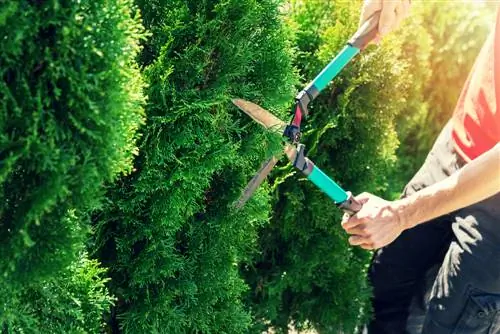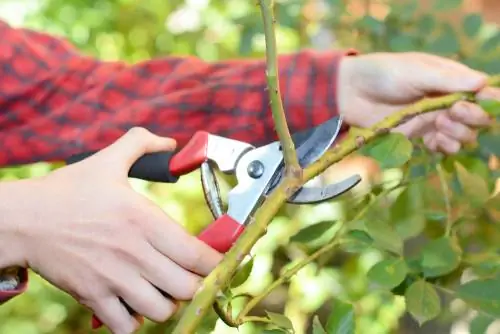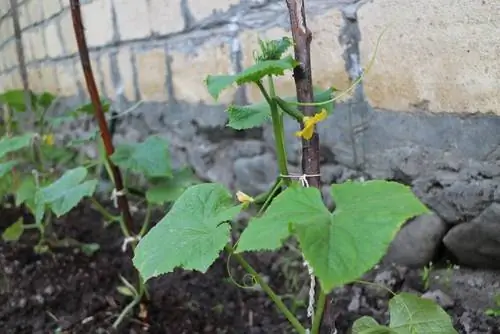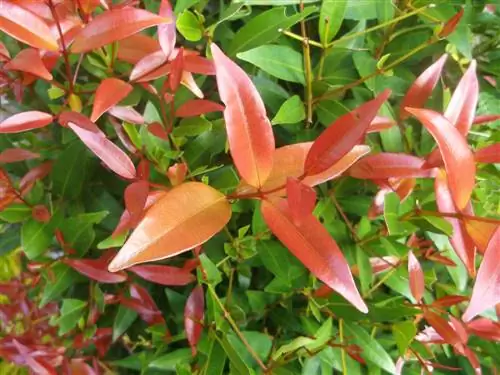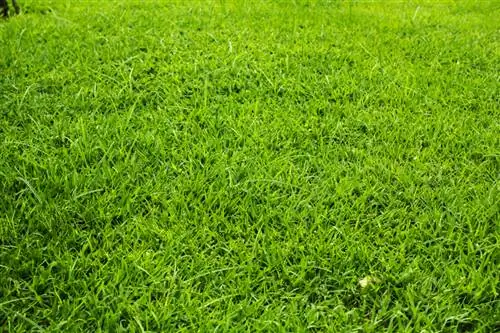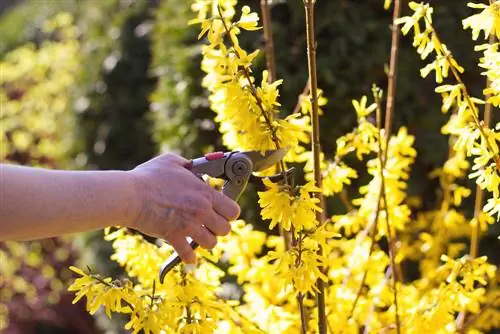- Author admin [email protected].
- Public 2023-12-16 16:46.
- Last modified 2025-06-01 06:02.
As a solitary plant and hedge, Thuja Smaragd makes other conifers fade with its intense colors. Anyone who doesn't simply leave the premium variety of arborvitae to its own devices will be rewarded with a long-lasting and attractive conifer with emerald green needles. This tutorial answers all questions about cutting care for Thuja occidentalis Smaragd.
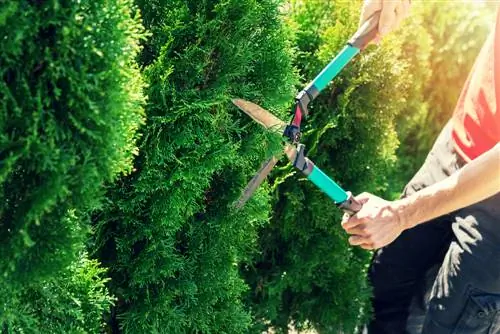
How to cut a Thuja Smaragd?
The Thuja Smaragd only grows 10-20 centimeters annually, but is up to 6 meters high and 2 meters wide. From the second year onwards, in February, individual trees are trimmed in a step shape and opaque hedges are trimmed conically. The previous year's growth is shortened to 4-5 centimeters.
Tricky cutting
If you have ordered your Thuja Smaragd to be pruned, the cutting process requires particular care. For conifers in general and arborvitae in particular, pruning can have fatal consequences if the specific growth is not taken into account. It is characteristic of Thuja occidentalis and other coniferous trees that they no longer sprout from old wood.
The cause of the handicap is the lack of sleeping eyes as an “iron growth reserve” when branches, twigs or trunks fail. Most deciduous trees produce a large number of dormant buds, which guarantee renewed growth after pruning. Thuja Smaragd is forever disfigured if you cut the bush into the old wood. As long as the cut is concentrated on thegreen-needled branch area, a tree of life proves to tolerate cutting well.
Occasions and dates for cutting - cutting types
A leisurely growth of 10 to 20 centimeters per year does not prevent Thuja Smaragd from reaching, uncut, a majestic height of 6 meters over the years and a spacious width of up to 2 meters. These dimensions result in significant space problems in small gardens. The concerns expressed about a radical cut recommend that you use pruning shears regularly. In order to keep growth under control without affecting the emerald green colors, the rule of thumb applies: it is better to cut frequently and moderately, rather than rarely and heavily. The following table familiarizes thuja gardeners with all the options for expert pruning care:
| Cut style | Goal/Occasion | best date |
|---|---|---|
| Solitaire construction cut | build a stable framework | Early February to early March |
| Build-up cut hedge | shape growth, dense branching | Early February to early March |
| Topiary hedge | Control of height and width growth, cutting into trapezoid shape | February |
| Care cutting hedge | Maintenance of shape, well-groomed appearance | End of June to mid-July |
| Solitaire clearing cut | Remove dead wood, maintain growth habit | February |
You can remove a radical rejuvenation cut from the list of sensible types of cuts without replacing it. Thuja Smaragd must never be pruned into old wood. This premise implies that you cannot put the conifer on the stick as a shrub or hedgewithout inviting total failure.
Set up a solitaire in a staircase shape
Thuja Smaragd is characterized by tightly upright and slender growth. High-quality young plants leave the nursery with several scaffold shoots. These compete with each other and usually sprout on the exposed side in order to win the race to the light. The result is a one-sided weight distribution, so that the tree of life falls apart under the influence of snow pressure or strong wind. A targeted pruning prevents the undesirable process and strengthens the stability within the conifer. How to do it right:
- The best time is from the second or third year in February
- Let the three strongest scaffolding shoots grow uncut as a supporting framework
- Cut side shoots extending from the scaffold in a step shape
Subject a solitary Thuja Smaragd to a close inspection every late winter. Pruning care is carried out perfectly when several side branches are gathered around three uncut main shoots at different heights. This is achieved through a derivation cut. To shorten a side shoot that is too long, look for a strong side branch in the upper third of theneedled area. Where both shoots fork, make the cut.
Background
Premature cutting of the main shoots marks the end of height growth
A Thuja Smaragd continues to grow upwards slowly but steadily as long as there are top buds on its central shoots. This applies equally to the pruning care of solitaires and hedges. Please only prune shoot tips if no further upward growth is desired. The growth law of tip promotion teaches us that after tip buds are removed, the growth forces are distributed to deeper buds. As a result, a Thuja Smaragd always expands when it is deprived of its top buds.
Build-up cut guarantees opaque hedge
Thuja Smaragd takes its time growing. With a growth rate of 10 to 30 centimeters, it takes many years of patience until the arborvitae form an opaque hedge. Understandably, every green centimeter is welcomed with joy, so gardeners do not prune their thuja hedges in the first few years. As a result, a loose habitus develops that is extremely susceptible to wind and snow pressure. For this reason, this tutorial advocates a gradual build-up pruning that aims to create a densely branched and lushly needled thuja emerald hedge. This is how it works:
- The best time is from the second year in February on a frost-free day
- Thuja emerald hedgebuild trapezoidal shape
- Stretch cords as a guide for the conical cutting profile
- Prune thelast year's growth to 4 or 5 centimeters
- Do not prune the hedge crown until the final height is reached
- Cut off branches growing into the interior of the hedge at the base
The step-by-step training of a thuja emerald hedge pays particular attention to all top buds as long as the desired final height has not been reached. Trim all sides and flanks to within 5 centimeters. The hedge should be wider at the base than in the crown area to ensure growth is flooded with light. Annual pruning of the lateral shoot tips in the needled area promotes dense branching because buds further down the shoot also benefit from the sap flow.
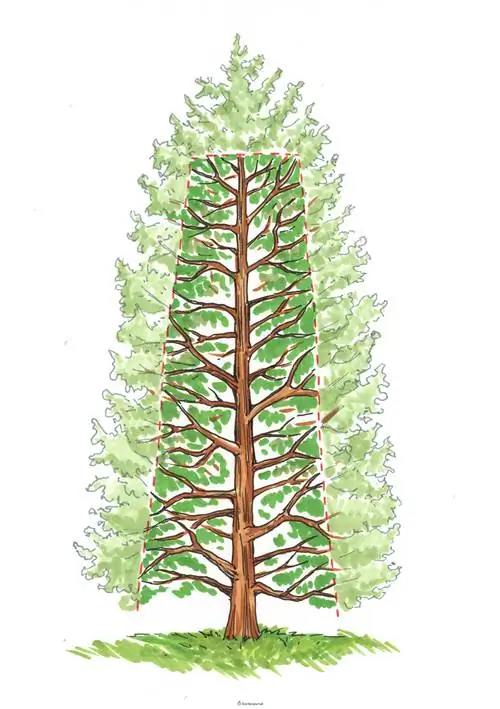
A trapezoidal cut profile is equally advantageous for solitary plants and hedges. If Thuja Smaragd grows a fifth to a third wider at the bottom than in the crown area, its shoots do not shade each other. This promotes photosynthesis and allows green needle scales to sprout deep into the interior of the plant.
Cut the thuja emerald hedge into shape
Once a thuja emerald hedge has reached the perfect height and density, the structure results in anannual topiary cut The cutting process is considerably simplified because you can clearly see them Be able to orientate yourself on interfaces from the previous year. There is no longer any danger of accidentally cutting too deeply into the old wood. This also eliminates the need to install orientation aids for the recommended trapezoid shape. How to complete the central topiary with horticultural expertise:
- The best time for topiary is in February when the weather is frost-free and overcast
- First thin out dead wood, crossing or touching shoots
- Set up the hedge trimmer so that the view is directed towards the uncut green area
- Swing the motorized shears evenly up and down, parallel to the hedge area
- Cutting as close as possible to last year's cuts
In contrast to the built-up cut, a topiary cut leaves only a few millimeters of fresh, green needle scales. To ensure a straight cutting surface, please work on the sides of the hedge with your arms stretched and from your shoulders. You can cut the hedge crown perfectly with pivoting movements from your back.
Excursus
Adequate tool for every type of cut
If you have the right cutting tool, cutting Thuja Smaragd is a gardening pleasure. In order to skilfully trim a hedge into shape, an electric hedge trimmer carries out the cutting work accurately and whisper-quietly. If the hedge is longer than 10 meters, you should ideally cut it with a petrol-powered hedge trimmer. In order to be independent of the battery or power cable, the noise of the machine is exceptionally accepted in order to cut the mighty green wall. The hedge trimmer can remain in the shed for topiary trimming on the solitaire. Since the cut focuses on individual branches, high-quality one-handed pruning shears tackle the task with flying colors. It is up to you to decide whether you prefer bypass or anvil shears.
Summer pruning for a well-groomed hedge appearance
Under ideal conditions, a thuja emerald hedge grows up to 30 centimeters a year. The well-groomed appearance suffers as a result because shoots protrude from the shape of the hedge. The ideal time window for a regular care cut isEnd of June. Near St. John's Day, June 24th, arborvitae and other plants take a short break in growth and then sprout again with reduced strength.
If you cut off a third of this year's growth in summer, your thuja emerald hedge will grow denser and bushier. Alternatively, just shorten branches that protrude from the shape. It is important to note that you prune by the beginning of September at the latest so that fresh shoots ripen in time before winter.
Breeding birds always have priority
The Federal Nature Conservation Act requires a strictgrace periodfor tree pruning. Basically it's from1. March to September 30thit is forbidden to trim hedges, bushes or treetops. The breeding season for native and foreign birds extends over the defined period. Any disruption or even displacement will result in fines of up to 50.000 euros fined. In exceptional cases, light maintenance cuts are permitted, provided they focus on this year's growth. Furthermore, before pruning, it must be ensured thatthere are no nests in the wood..
Examine Thuja Smaragd carefully for feathered inhabitants before any pruning. If you find what you are looking for, please postpone the cutting time until later. A tree of life can easily cope with pruning at the end of the breeding season between mid to late August.
Tip
When choosing a date for pruning Thuja Smaragd, follow this rule of thumb: Never prune in frost, strong heat or blazing sun.
Solitaire benefits from the thinning cut
If a solitary Thuja Smaragd has been given a professional cut, pruning care is reduced to the occasional thinning out of dead wood. As the illustration below illustrates, you can use this opportunity to cut back shoots that are too long or low hanging. How to do it right:
- Solitary Thuja Smaragd thin out every 3 to 5 years
- Saw off dead wood on a branch without damaging the trunk bark
- The best time is in February when the weather is frost-free
- Excessively long, arched branches lead to a side shoot
If you find yourself forced to thin out a dead or unfavorable branch, there is a risk of a large, dark gap. In this case, only cut after you have experimentally bent the shoot in question to the side. If the hole is too big, move the cutting point further out.
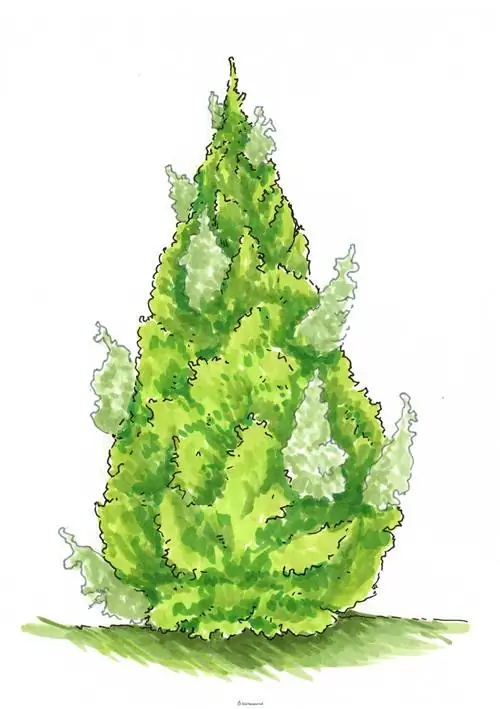
Thuja Smaragd that is too large with unkempt, drooping shoots can be brought back into balance with a combination of thinning and topiary pruning. Thin out dead branches. Long, overhanging branches can be shortened using a derivation cut.
Background
Leading cut prevents brown gaps
The cutting technique of derivation helps private and professional gardeners overcome many hurdles in pruning care. Designed for perfect fruit wood cutting on fruit trees, a derivative cut also guarantees the optimal cutting result on ornamental trees, such as Thuja Smaragd. If a branch is too long, don't just cut it anywhere. Instead, choose the intersection at the fork to a young, fresh side shoot. The previously subordinate branch will now assume a leadership position at this point without creating a disturbing gap in its appearance. You can also use the derivation to shorten a tree of life that has grown too high.
Frequently asked questions
Accidentally cut into the old wood so that my Thuja Smaragd now has a gap - what should I do?
If you don't pay attention for a moment, the scissors will end up in the area where the shoots have not been needled. To ensure that there is no permanent gap affecting your Thuja Smaragd at this point, proceed as follows: Pull neighboring green branches into the gap and tie them there. When tying, please use soft tube ties that do not cut into the bark. It may take some time until the resulting gap has grown and the binding material can be removed again.
Is Thuja Smaragd suitable for keeping in a pot? If so, how big should the pot be?
Trees of life have no objection to cultivation in pots. As long as there is an adequate supply of water and nutrients, the conifers will thrive just as well as in the bed. To prevent a Thuja Smaragd from tipping over in the pot, the container should always be wider than the plant. At the beginning we recommend a pot volume of 25 to 30 liters. Parallel to the growth, the bucket must regularly increase in size so that the dimensions are correct.
We would like to plant an easy-care, evergreen conifer hedge that is a maximum of 200 to 250 centimeters high and 50 centimeters wide. When we say easy to care for, we associate it with little effort for pruning. Is Thuja Smaragd a suitable variety for this plan?
Among the most popular arborvitae varieties, Thuja Smaragd grows the slowest. Furthermore, the conifer remains overall lower and slimmer than varieties such as Columna or Malonyana. As it gets older, Thuja Smaragd will of course significantly exceed the desired height and width. By pruning the hedge early, once a year, you keep the growth habit compact and narrow. Regular cutting is better than cutting the bushes once to 250 centimeters when they have become too large. In this case, there is a noticeable increase in thickness in the lower area, which requires an even stronger shape cut.
I am planning to plant Thuja Smaragd as a fencing hedge in a new development area. The soil condition is problematic because it is a former field that was filled with sand and gravel to a depth of 170 centimeters, so that there are hardly any humus components present. How deep does the tree of life variety have roots and how do I have to create the planting trench?
The thuja hedge will not grow in sandy-gravelly soil. The root depth of Thuja Smaragd depends largely on the local conditions, so a specific measurement cannot be made. Experience has taught us that in normal garden soil a root depth of 50 to 75 centimeters is reached after 10 years. We therefore recommend digging a 1 meter wide and deep trench for the thuja hedge, which you fill with topsoil.
I am forced to cut back a 25-year-old thuja emerald hedge, deep into the old wood. The vertical main shoots still have residual green at the tips. Can I stimulate growth here by cutting the branches and inserting a young green branch into the slot, similar to grafting fruit trees?
It is almost certain that scoring is just as unlikely to be successful as finishing. Conifers have stopped growing forever in the old wood. This also applies to Thuja Smaragd. After a vigorous pruning, the hedge will only sprout again if it is limited to the green area.
The 3 most common cutting mistakes
If the emerald green needles are marred by brown spots or the thuja emerald hedge is bare, the gardener has made a classic pruning mistake. In order to protect the readers of this tutorial from making mistakes in incision care, the following table lists the three most common mistakes with tips for effective prophylaxis:
| Cutting errors | malicious image | Prevention |
|---|---|---|
| cut into old, brown wood | no more green shoots, brown spots | always cut in the green needled shoot area |
| no trapezoid shape when cutting hedges | bare, patchy hedge base, premature balding from the inside out | conical hedge profile with wide base and narrow crown |
| cut in heat and blazing sun | brown, dried shoot tips | ideally blend when the sky is cloudy |
Tip
When thuja emerald bushes fence in the property as a hedge, the shiny green shoots near the ground sometimes turn brown in winter. The cause is road s alt, which is still used in many communities to keep icy roads passable. As a preventive measure, put up foil as a protective wall in front of your thuja emerald hedge. On mild days, shower the arborvitae to remove s alty spray water. In February, cut off browned shoot tips with hedge trimmers.

